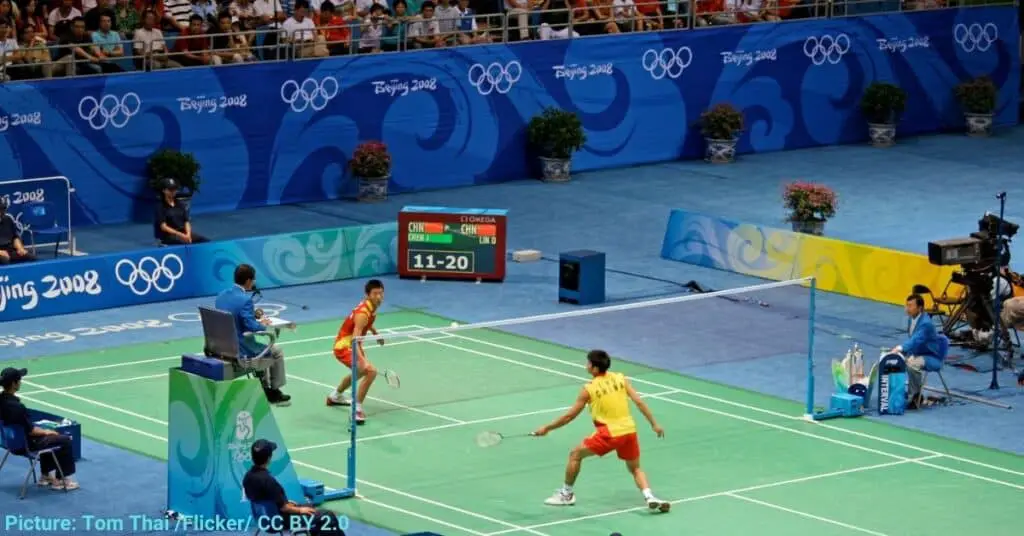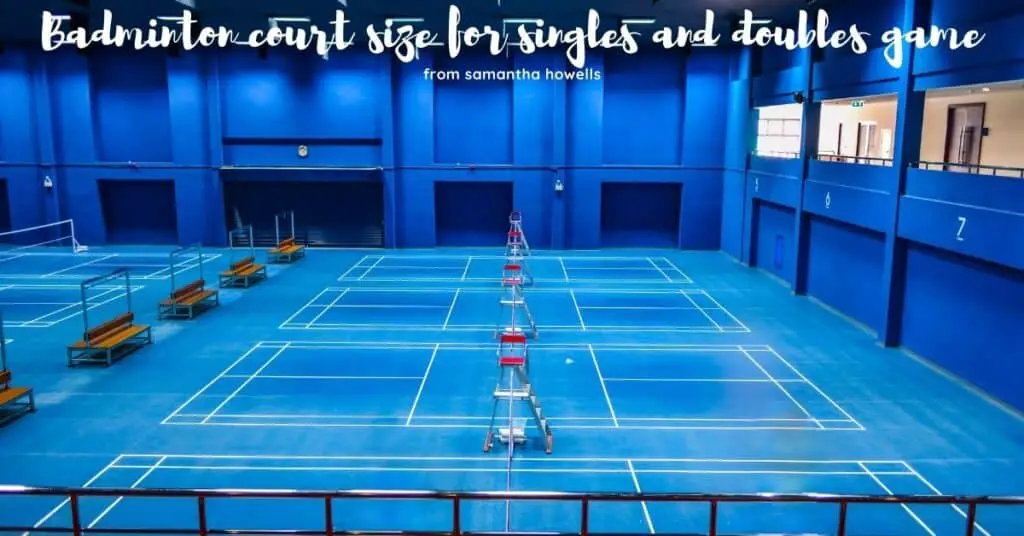Before going to the badminton rules, let’s have a quick recap on the game of badminton.
What is Badminton?
Badminton is a sport that involves two or four players for singles and doubles games respectively. It is played on a surface marked with specified dimensions called the badminton court. The game is played with the help of a racket that hits a shuttlecock to cross over the net with the intention to land on the specified area of the opponent’s side. It looks simple! Yes, but it must follow the rules and regulations governed by the Badminton World Federation (BWF) which we know as “The Laws of Badminton”.
Rules in Badminton
Let’s look at the basic rules of Badminton that are essential to follow in the game of badminton.
1. Toss in Badminton
Before the start of the play, the choice of side or service is decided by conducting a toss.
The side winning the toss may decide
- To serve first
- To receive first
- Any particular side of the court to start the match
The losing side then opts for any of the remaining choices.
2. Side Change in Badminton
The change of the ends occurs in the following situations.
- After the end of the 1st game
- At the end of the second game, if the match continues up to 3rd game
- In the 3rd game, when the score first reaches 11 points.
3. Badminton Scoring Rules
- During a rally, the server and the receiver hit the shuttle alternatively from any position on their side.
- In doubles, either player of the pair can hit the shuttle.
- The rally continues until there is a fault by any side or the placement of the shuttle is not within the specified area. The side that wins the rally, earns a point.
- If the server wins the point, he shall serve from the alternate service court.
- If the receiver earns the point, he will be the new server.
- A game consists of 21 points.
- The side that first reaches 21 points, and wins the game.
- If there is a situation of 20-20 in the game, a 2-point lead is necessary to win the game.
- If the game arrives at 29-29, the side that scores the 30th point wins the game.
- The points of the serving side count first. If the points of the server/ pair are 5 and the receiving side is on 2, the score will be 5-2.
- If the shuttle touches the marking line, it is a valid service /return.
- A match consists of 3 games.
Lets
“ Let” is the interruption of the play in badminton and the server has to serve again. There is “Let” in badminton in the following situations.
- When the server delivers the service before the receiver is in ready condition.
- When both the server and the receiver commit a fault.
- If the base of the shuttle gets separated from the rest of the shuttle.
- Any unusual or accidental occurrence during the match
Faults
Under the following condition, it is considered a fault, when
- The shuttle lands outside the boundary markings of the court.
- If the server fails to serve in the specified area of the opponent’s court.
- The shuttle obstructs the net.
- If any player hits the shuttle twice in succession.
- If in doubles, a player and his partner hit the shuttle successively.
- The shuttle touches the body or the dress of a player.
- If any player touches the net with his racket, dress, or in person.
- If any player invades his opponent’s court over the net with a racket or in person.
Badminton Singles Rules
A singles match involves two players. There is an outer sideline on which the posts are fixed. This sideline has no importance in the singles game. The area earmarked by the inner sideline and the back boundary line is specified for the singles game.
The rules for a singles badminton match that you need to know and follow are as below:
1. Serving and Receiving Courts
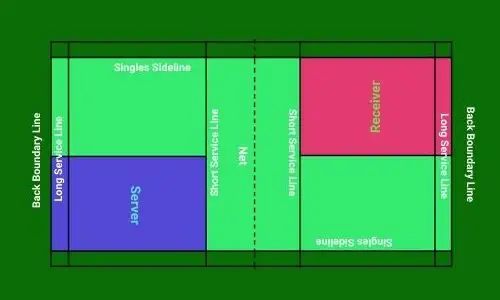
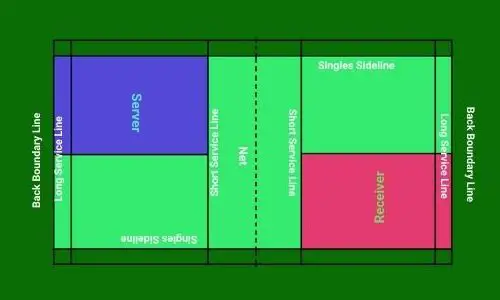
- For even numbers of points like 0 (at the time of the 1st service of a game), 2, 4, and so on, the server shall serve from the right service court and the receiver shall stand on the right service court.
- For an odd no of points, like 1, 3, 5, and so on, the player shall deliver service from the left service court and the receiver shall stand on the left service court to receive the service.
2. Service Area
- The service must go beyond the short service line but within the back boundary line.
- The service must also land within the singles service line and the centerline.
3. Service Rules in Badminton
You must know the service rules of badminton. The following rules will restrict you from doing the wrong service in badminton.
- The server and the receiver shall stand within the diagonally opposite service courts without touching the boundary lines.
- Both players shall contact the surface of the court with both feet in a stationary position from the start to the end of the service.
- The position of the shuttle shall be below 1.15 meters from the surface of the court at the instant of being hit by the server.
- The server only shall deliver the service after the receiver is ready.
- The server shall move his racket forward from the start to the end of the service.
- If the server misses the shuttle to hit, it is considered delivered.
- The server must hit the base of the shuttle.
- The server has to serve diagonally from his service court to the receiver’s service court.
Badminton Doubles Rules
In badminton, there are some variations in the rules of doubles against the rules of singles. For doubles, the right, and left alleys down the sidelines are included. So the court size is bigger compared to a singles game. The number of players in doubles is 4 where there is a pair of 2 players for each side.
Badminton Serving Rules for Doubles
1. Serving and Receiving Courts
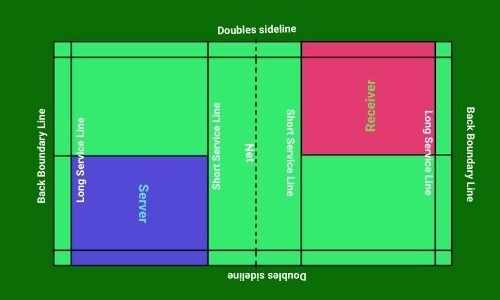
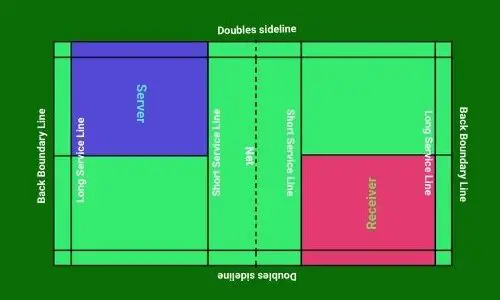
- Like in singles, the service side shall serve from the right service court when there is no score or even number of points for the serving side. For the odd number of points of the serving side, the service court shall be the left one.
- If the serving side wins the point, the score becomes 1-0, so the server moves to the left service court to deliver service, and his partner moves to the right service court.
- The position of the receiver and his partner remains the same.
Let’s illustrate it with an example.
A and B (Team A) is paired to play against the pair of C and D (Team C). Team A wins the toss and decides to serve.
A serves diagonally from his right service court ( as the score is 0 – 0) to C.
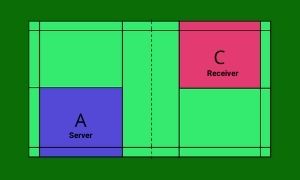
Team A wins the point and the score becomes 1-0, so A has to move to the left service court (1 is the odd number) to serve diagonally to D.
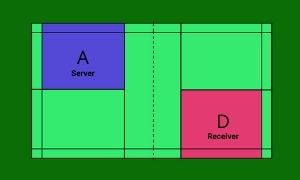
Now, team C wins the point and the score becomes 1-1. Now it’s the turn for the service of team C. So D serves A diagonally from the left service court. ( As 1 is the odd number).
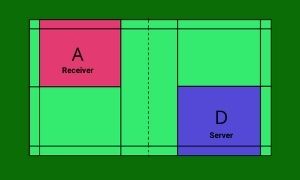
Again, team C wins the point and leads with a score of 2-1. So D moves to the right service court ( as 2 is the even number) to serve diagonally to B.
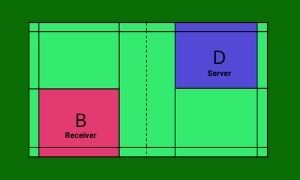
Now team A wins the point to level the score at 2-2. So, it’s the turn of B to deliver service diagonally from the right service court as 2 is the even number) to D.
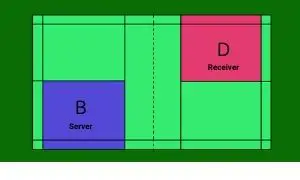
The game continues in this system till the end of the match.
2. Service Area
- The service must go beyond the short service line but within the inner long service line for doubles.
- The width of the service court exceeds from the centerline to the doubles sideline.
FAQ
The length of a badminton court is 44 feet (13.40 m) and the width is 20 feet (6.1 m).
The player who first scores 21 points, wins the game. But there are two exceptions.
If the game arrives at 20-20, a 2-point lead is necessary to become the winner.
If the game arrives at 29-29, the side that scores the 30th point wins the game.
Yes, it is a fault in the game of badminton.
Yes, the partners are allowed to take up any position within their respective courts until they do not obstruct the view of the server or the receiver.
No, it is a fault if he touches the net with his racket or in person.
Yes, it is a valid point.
Yes, a clash of rackets is not a fault in badminton until the shuttle touches only one racket.
Yes, it is a valid service if you hit the shuttle at the base and the flight of the shuttle is upward to pass over the net and land on the specified area of the service court.
Related Post:

